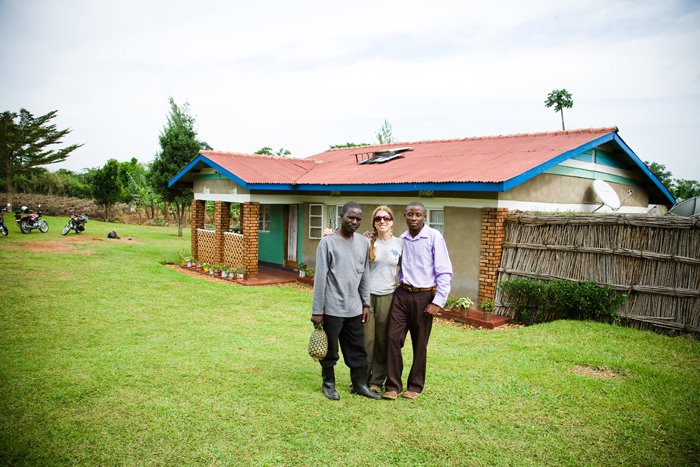when we arrived in uganda, we met up with our ugandan teammates and had an orientation for how our mapping survey would work. below is a picture of moses, me and julius- my two teammates for the two weeks- in front of julius’ crib (as he likes to call it).
 we mapped in two different regions of uganda with the intent of creating a GIS map when it was all said and done that indicated the state of water, sanitation and hygiene for each community. in total, we mapped over 600 water sources.
we mapped in two different regions of uganda with the intent of creating a GIS map when it was all said and done that indicated the state of water, sanitation and hygiene for each community. in total, we mapped over 600 water sources.
when my teammates and i first arrived in a village we sought out the chairman of the village who would then guide us to all the water sources and assist with our questions. below is the chairman and the woman leader of ‘buyuki’.
 a lot of hiking was involved to reach the water sources. often, a resident would lead us to the water source and answer survey questions while we took GPS readings and pictures of the water source.
a lot of hiking was involved to reach the water sources. often, a resident would lead us to the water source and answer survey questions while we took GPS readings and pictures of the water source.
 i encountered three different kinds of water sources while in uganda. the best sources were boreholes with handpumps. it is often the job of women and children to fetch water.
i encountered three different kinds of water sources while in uganda. the best sources were boreholes with handpumps. it is often the job of women and children to fetch water.
 i also encountered several pumps that no longer worked. here is the chairman of ‘namagulwe’ next to a pump that has not worked for years. the villages do not have the technical ability, nor the funds to repair the pumps. this community hikes down the hill past this pump to a hole in the ground where they fetch their water.
i also encountered several pumps that no longer worked. here is the chairman of ‘namagulwe’ next to a pump that has not worked for years. the villages do not have the technical ability, nor the funds to repair the pumps. this community hikes down the hill past this pump to a hole in the ground where they fetch their water.
 i saw more springs than pumps in uganda. these provide a decent source of water, but are always located at a low elevation, thus requiring quite the hike, and also most of them dry up during the dry season.
i saw more springs than pumps in uganda. these provide a decent source of water, but are always located at a low elevation, thus requiring quite the hike, and also most of them dry up during the dry season.
 more often than anything else, i saw people fetching their water from these little ponds, essentially holes in the ground. they are rather stagnant and are open to contamination from animals and runoff.
more often than anything else, i saw people fetching their water from these little ponds, essentially holes in the ground. they are rather stagnant and are open to contamination from animals and runoff.
 these are the containers that are used to fetch water. the largest one weighs about 40 pounds when full.
these are the containers that are used to fetch water. the largest one weighs about 40 pounds when full.
 a lot of hiking was involved to reach the water sources. often, a resident would lead us to the water source and answer survey questions while we took GPS readings and pictures of the water source.
a lot of hiking was involved to reach the water sources. often, a resident would lead us to the water source and answer survey questions while we took GPS readings and pictures of the water source. i encountered three different kinds of water sources while in uganda. the best sources were boreholes with handpumps. it is often the job of women and children to fetch water.
i encountered three different kinds of water sources while in uganda. the best sources were boreholes with handpumps. it is often the job of women and children to fetch water. i also encountered several pumps that no longer worked. here is the chairman of ‘namagulwe’ next to a pump that has not worked for years. the villages do not have the technical ability, nor the funds to repair the pumps. this community hikes down the hill past this pump to a hole in the ground where they fetch their water.
i also encountered several pumps that no longer worked. here is the chairman of ‘namagulwe’ next to a pump that has not worked for years. the villages do not have the technical ability, nor the funds to repair the pumps. this community hikes down the hill past this pump to a hole in the ground where they fetch their water. i saw more springs than pumps in uganda. these provide a decent source of water, but are always located at a low elevation, thus requiring quite the hike, and also most of them dry up during the dry season.
i saw more springs than pumps in uganda. these provide a decent source of water, but are always located at a low elevation, thus requiring quite the hike, and also most of them dry up during the dry season. more often than anything else, i saw people fetching their water from these little ponds, essentially holes in the ground. they are rather stagnant and are open to contamination from animals and runoff.
more often than anything else, i saw people fetching their water from these little ponds, essentially holes in the ground. they are rather stagnant and are open to contamination from animals and runoff. these are the containers that are used to fetch water. the largest one weighs about 40 pounds when full.
these are the containers that are used to fetch water. the largest one weighs about 40 pounds when full.think about each time you use water… then imagine hiking a half mile down a steep hill to then carry 40 pounds of water, barefoot, back up the steep hill another half a mile
 our second region, kyjenjojo, was very hilly and did not have many roads that were passable by car. we had to use ‘boda bodas’ to get close to the water sources.
our second region, kyjenjojo, was very hilly and did not have many roads that were passable by car. we had to use ‘boda bodas’ to get close to the water sources. water for people provided us with water for our field work. at first i was carrying my empty water bottles around until i saw my teammates just throwing them onto the ground. i couldn’t understand the littering so i asked them why they would just throw it there. they explained that someone would reuse it. from then on, i always gave my bottles to the little kids. they loved collecting them and i know they will use them until they can be used no longer.
water for people provided us with water for our field work. at first i was carrying my empty water bottles around until i saw my teammates just throwing them onto the ground. i couldn’t understand the littering so i asked them why they would just throw it there. they explained that someone would reuse it. from then on, i always gave my bottles to the little kids. they loved collecting them and i know they will use them until they can be used no longer. this image always gets me. these children are literally getting their water from this source. it doesn’t take a genius to realize it is unsafe water. they will have to spend time boiling the water to make it safe, and i was told that sometimes people do not even boil it.
this image always gets me. these children are literally getting their water from this source. it doesn’t take a genius to realize it is unsafe water. they will have to spend time boiling the water to make it safe, and i was told that sometimes people do not even boil it. water is essential for life. the ugandans i met understand this and they also understand that they do not have safe water. they are not ignorant to the fact that their water sources are unsafe, but they need water to survive…
water is essential for life. the ugandans i met understand this and they also understand that they do not have safe water. they are not ignorant to the fact that their water sources are unsafe, but they need water to survive… 
